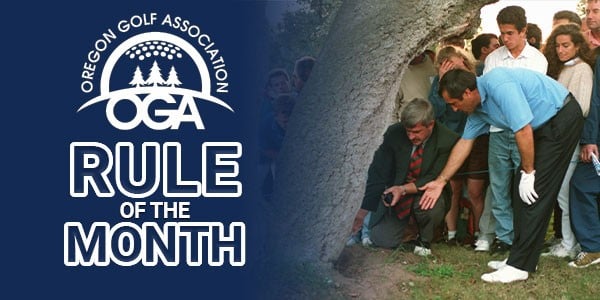Are you still with us? No one promised that Rule 14 would be earth-shattering, but trust us when we say that understanding this one Rule is more than half the battle to playing golf by the Rules. This month, we will explore the many situations that happen when a player is required to replace a ball on a specific spot. And while there are many times when a player gets one penalty stroke for a procedural breach, replacing the ball incorrectly could also result in the player getting the general penalty for playing from a wrong place. In other words, not knowing what to do when replacing your ball will cost you a loss of hole penalty in match play or two penalty strokes in stroke play.
Test your knowledge regarding the replacing of your ball when a Rule requires it to be replaced on a specific spot with the following questions.
Questions: True / False
1) When a Rule requires that the ball be replaced on its original spot, but that spot is unknown because the ball was accidentally moved, the ball must be dropped within one club-length of the estimated spot of the ball.
2) A ball has come to rest on a leaf and the player wishes to lift the ball to identify it (the ball not the leaf😉). Before replacing the ball, the player may remove the leaf.
3) While searching for a ball in a bunker, the player accidentally causes their ball, which was buried in sand, to move and is required to replace the ball. The lie of the ball was altered when the ball was moved. The player must re-create the original lie of the ball by burying it, but may leave a small part of it visible.
4) A player’s ball, in the general area, is run over by another player’s cart and is pushed into the soft earth. Since the original lie of the ball has been altered, the player may replace by placing the original ball or another ball on the nearest spot with a lie most similar to the original lie that is within one club-length from its original spot, not nearer the hole and in the same area of the course.
5) To replace a ball properly, the player must set it down by hand and let it go with the intent for it to be in play.
6) If the player attempts to replace a ball but it will not stay on its original spot, the player must try to replace it again on the same spot.
7) If the ball will not remain on the original spot, or the estimated spot, on the player’s second attempt, the original ball or another ball may be dropped within one club-length of the original spot.
8) Continuation of Question #7. If the original spot was in the general area, putting green, bunker or a penalty area, the nearest spot where the ball will remain at rest must also be in that same area of the course.
9) Continuation of Questions #7 and #8. A player’s ball comes to rest on the downslope of a bunker against a rake. When the rake is moved, the ball moves and the player attempts to replace it twice. It is determined that there are no spots where the ball will remain at rest in the bunker that are not nearer the hole. The player must take unplayable ball relief either by using the stroke and distance option for one penalty stroke and playing from where their previous stroke was made, or back-on-the-line relief outside the bunker for two penalty strokes.
10) In a Four-Ball competition, your partner may replace your ball for you and any breaches of the Rules are treated as breaches by you.
---
Answers:
1) False. Rule 14.2c. The proper procedure is to estimate the original spot and replace the original ball by placing it on this estimated spot.
2) False. Rules 14.2c and 15.1a Exception 1. Since removing the leaf before lifting the ball would have been likely to cause the ball to move, the player is not allowed to deliberately remove the leaf before replacing the ball. However, if the leaf moved as a result of the lifting of the ball, the player does not need to replace the leaf.
3) True. Rule 14.2d(1). When a player is required to replace a ball that was in sand, whether in a bunker, penalty area or the general area, they are required to re-create the lie. If they are not sure of the lie or of the original spot, both should be estimated and the lie re-created. If the player fails to re-create the lie, they are in breach of this Rule and get the general penalty.
4) False. Rule 14.2d(2). Reading this question too quickly may have caught you off-guard. All of it is true with the exception that the player is not allowed to use another ball and must use the original ball. It is important to note that this applies whenever the lie of a ball that must be replaced is altered anywhere on the course except in sand. See Question #3 for when the lie of a ball that is in sand is altered and the ball must be replaced.
5) True. Rule 14.2b and the definition of Replace. We re-visit this question for two purposes. First, to highlight the fact that the original ball must be replaced by placing it with the hand and letting it go. Rolling the ball with a club or any other way of replacing is not allowed. And second, as a preface to the following questions regarding when the ball is let go of. Read on.
6) True. Rule 14.2e. The player must try again to replace the ball by placing it on the original spot.
7) False. Rule 14.2e. In this situation, the original ball will still be replaced by placing it on the nearest spot, no closer to the hole, where the ball will remain at rest. Read on for certain limitations depending on the location of that original spot.
8) False. Rule 14.2e. Most of this question is true because if the original spot was in the general area, bunker or a penalty area, the nearest spot where the ball will remain at rest must also be in that particular area of the course. However, when the original spot is on the putting green, the nearest spot where the ball will remain at rest that is not nearer the hole must be either on the putting green or in the general area.
9) True. Rule 14.2e and Clarification 14.2e/1. This situation, which occurs frequently, is taken directly from the Clarification listed above. The player is not allowed to push the ball into the sand or ground to ensure that it remains on the spot. Unfortunately, in this case, the player must declare the ball unplayable and use one of the options outlined.
10) True. Rule 23.5. Action of your partner concerning your ball or equipment is treated as having been taken by you. Pick your partner carefully.


